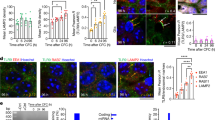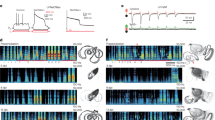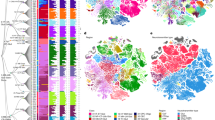Abstract
β-catenin has been implicated in neuronal synapse regulation and remodeling. Here we have examined β-catenin expression in the adult mouse brain and its role in amygdala-dependent learning and memory. We found alterations in β-catenin mRNA and protein phosphorylation during fear-memory consolidation. Such alterations correlated with a change in the association of β-catenin with cadherin. Pharmacologically, this consolidation was enhanced by lithium-mediated facilitation of β-catenin. Genetically, the role of β-catenin was confirmed with site-specific deletions of loxP-flanked Ctnnb1 (encoding β-catenin) in the amygdala. Baseline locomotion, anxiety-related behaviors and acquisition or expression of conditioned fear were normal. However, amygdala-specific deletion of Ctnnb1 prevented the normal transfer of newly formed fear learning into long-term memory. Thus, β-catenin may be required in the amygdala for the normal consolidation, but not acquisition, of fear memory. This suggests a general role for β-catenin in the synaptic remodeling and stabilization underlying long-term memory in adults.
This is a preview of subscription content, access via your institution
Access options
Subscribe to this journal
Receive 12 print issues and online access
$209.00 per year
only $17.42 per issue
Buy this article
- Purchase on Springer Link
- Instant access to full article PDF
Prices may be subject to local taxes which are calculated during checkout







Similar content being viewed by others
References
Harris, K.M. & Kater, S.B. Dendritic spines: cellular specializations imparting both stability and flexibility to synaptic function. Annu. Rev. Neurosci. 17, 341–371 (1994).
Nimchinsky, E.A., Sabatini, B.L. & Svoboda, K. Structure and function of dendritic spines. Annu. Rev. Physiol. 64, 313–353 (2002).
Matsuzaki, M., Honkura, N., Ellis-Davies, G.C. & Kasai, H. Structural basis of long-term potentiation in single dendritic spines. Nature 429, 761–766 (2004).
Nagerl, U.V., Eberhorn, N., Cambridge, S.B. & Bonhoeffer, T. Bidirectional activity-dependent morphological plasticity in hippocampal neurons. Neuron 44, 759–767 (2004).
Yuste, R. & Bonhoeffer, T. Morphological changes in dendritic spines associated with long-term synaptic plasticity. Annu. Rev. Neurosci. 24, 1071–1089 (2001).
Gumbiner, B.M. Cell adhesion: the molecular basis of tissue architecture and morphogenesis. Cell 84, 345–357 (1996).
Murase, S., Mosser, E. & Schuman, E.M. Depolarization drives beta-catenin into neuronal spines promoting changes in synaptic structure and function. Neuron 35, 91–105 (2002).
Salinas, P.C. & Price, S.R. Cadherins and catenins in synapse development. Curr. Opin. Neurobiol. 15, 73–80 (2005).
Takeichi, M. & Abe, K. Synaptic contact dynamics controlled by cadherin and catenins. Trends Cell Biol. 15, 216–221 (2005).
Logan, C.Y. & Nusse, R. The Wnt signaling pathway in development and disease. Annu. Rev. Cell Dev. Biol. 20, 781–810 (2004).
Moon, R.T., Kohn, A.D., De Ferrari, G.V. & Kaykas, A. WNT and beta-catenin signalling: diseases and therapies. Nat. Rev. Genet. 5, 691–701 (2004).
Chen, J., Park, C.S. & Tang, S.J. Activity-dependent synaptic Wnt release regulates hippocampal long term potentiation. J. Biol. Chem. 281, 11910–11916 (2006).
Machon, O., van den Bout, C.J., Backman, M., Kemler, R. & Krauss, S. Role of beta-catenin in the developing cortical and hippocampal neuroepithelium. Neuroscience 122, 129–143 (2003).
Roura, S., Miravet, S., Piedra, J., Garcia de Herreros, A. & Dunach, M. Regulation of E-cadherin/Catenin association by tyrosine phosphorylation. J. Biol. Chem. 274, 36734–36740 (1999).
Behrens, J. et al. Functional interaction of an axin homolog, conductin, with beta-catenin, APC, and GSK3beta. Science 280, 596–599 (1998).
Peifer, M., Pai, L.M. & Casey, M. Phosphorylation of the Drosophila adherens junction protein Armadillo: roles for wingless signal and zeste-white 3 kinase. Dev. Biol. 166, 543–556 (1994).
Yost, C. et al. The axis-inducing activity, stability, and subcellular distribution of beta-catenin is regulated in Xenopus embryos by glycogen synthase kinase 3. Genes Dev. 10, 1443–1454 (1996).
Gould, T.D., O'Donnell, K.C., Picchini, A.M. & Manji, H.K. Strain differences in lithium attenuation of D-amphetamine-induced hyperlocomotion: a mouse model for the genetics of clinical response to lithium. Neuropsychopharmacology 32, 1321–1333 (2007).
Davies, S.P., Reddy, H., Caivano, M. & Cohen, P. Specificity and mechanism of action of some commonly used protein kinase inhibitors. Biochem. J. 351, 95–105 (2000).
Brault, V. et al. Inactivation of the beta-catenin gene by Wnt1-Cre-mediated deletion results in dramatic brain malformation and failure of craniofacial development. Development 128, 1253–1264 (2001).
Piedra, J. et al. Regulation of beta-catenin structure and activity by tyrosine phosphorylation. J. Biol. Chem. 276, 20436–20443 (2001).
Bamji, S.X., Rico, B., Kimes, N. & Reichardt, L.F. BDNF mobilizes synaptic vesicles and enhances synapse formation by disrupting cadherin-beta-catenin interactions. J. Cell Biol. 174, 289–299 (2006).
Rattiner, L.M., Davis, M., French, C.T. & Ressler, K.J. Brain-derived neurotrophic factor and tyrosine kinase receptor B involvement in amygdala-dependent fear conditioning. J. Neurosci. 24, 4796–4806 (2004).
Gould, T.D. et al. Beta-catenin overexpression in the mouse brain phenocopies lithium-sensitive behaviors. Neuropsychopharmacology 32, 2173–2183 (2007).
McGaugh, J.L. The amygdala modulates the consolidation of memories of emotionally arousing experiences. Annu. Rev. Neurosci. 27, 1–28 (2004).
McGaugh J.L., Roozendaal, B. Role of adrenal stress hormones in forming lasting memories in the brain. Curr. Opin. Neurobiol. 12, 205–210 (2002).
Chhatwal, J.P., Hammack, S.E., Jasnow, A.M., Rainnie, D.G. & Ressler, K.J. Identification of cell-type-specific promoters within the brain using lentiviral vectors. Gene Ther. 14, 575–583 (2007).
Chhatwal, J.P., Stanek-Rattiner, L., Davis, M. & Ressler, K.J. Amygdala BDNF signaling is required for consolidation but not encoding of extinction. Nat. Neurosci. 9, 870–872 (2006).
Heldt, S.A., Stanek, L., Chhatwal, J.P. & Ressler, K.J. Hippocampus-specific deletion of BDNF in adult mice impairs spatial memory and extinction of aversive memories. Mol. Psychiatry 12, 656–670 (2007).
Naldini, L., Blomer, U., Gage, F.H., Trono, D. & Verma, I.M. Efficient transfer, integration, and sustained long-term expression of the transgene in adult rat brains injected with a lentiviral vector. Proc. Natl. Acad. Sci. USA 93, 11382–11388 (1996).
Naldini, L. et al. In vivo gene delivery and stable transduction of nondividing cells by a lentiviral vector. Science 272, 263–267 (1996).
Tiscornia, G., Singer, O. & Verma, I.M. Production and purification of lentiviral vectors. Nat. Protoc. 1, 241–245 (2006).
Zufferey, R., Donello, J.E., Trono, D. & Hope, T.J. Woodchuck hepatitis virus posttranscriptional regulatory element enhances expression of transgenes delivered by retroviral vectors. J. Virol. 73, 2886–2892 (1999).
Heldt, S.A., Stanek, L., Chhatwal, J.P. & Ressler, K.J. Hippocampus-specific deletion of BDNF in adult mice impairs spatial memory and extinction of aversive memories. Mol. Psychiatry 12, 656–670 (2007).
Jones, S.V., Heldt, S.A., Davis, M. & Ressler, K.J. Olfactory-mediated fear conditioning in mice: simultaneous measurements of fear-potentiated startle and freezing. Behav. Neurosci. 119, 329–335 (2005).
Paxinos, G. & Watston, C. The Mouse Brain in Stereotaxic Coordinates (Academic, New York, 2003).
Acknowledgements
This work was supported by the National Institutes of Health (MH069884, DA019624 and AG025688), the National Science Foundation (GRFP DGE-0234618), the Center for Behavioral Neuroscience (NSF agreement IBN-987675), the Burroughs Wellcome Fund and an NIH/National Center for Research Resources base grant (P51RR000165) to the Yerkes National Primate Research Center.
Author information
Authors and Affiliations
Contributions
K.A.M. initiated the project, conducted the experiments and data analysis and wrote the draft versions of the manuscript. K.J.R. supervised the project, assisted with data analysis and experimental planning, and contributed to draft and revised versions of the manuscript.
Corresponding author
Supplementary information
Supplementary Text and Figures
Supplementary Figure 1 and Supplementary Methods (PDF 235 kb)
Rights and permissions
About this article
Cite this article
Maguschak, K., Ressler, K. β-catenin is required for memory consolidation. Nat Neurosci 11, 1319–1326 (2008). https://doi.org/10.1038/nn.2198
Received:
Accepted:
Published:
Issue Date:
DOI: https://doi.org/10.1038/nn.2198
This article is cited by
-
Understanding Glycogen Synthase Kinase-3: A Novel Avenue for Alzheimer’s Disease
Molecular Neurobiology (2023)
-
Nk3R blockade has sex-divergent effects on memory in mice
Biology of Sex Differences (2022)
-
Amygdala DCX and blood Cdk14 are implicated as cross-species indicators of individual differences in fear, extinction, and resilience to trauma exposure
Molecular Psychiatry (2022)
-
Interactions Among Brain-Derived Neurotrophic Factor and Neuroimmune Pathways Are Key Components of the Major Psychiatric Disorders
Molecular Neurobiology (2022)
-
Integration of peripheral transcriptomics, genomics, and interactomics following trauma identifies causal genes for symptoms of post-traumatic stress and major depression
Molecular Psychiatry (2021)



